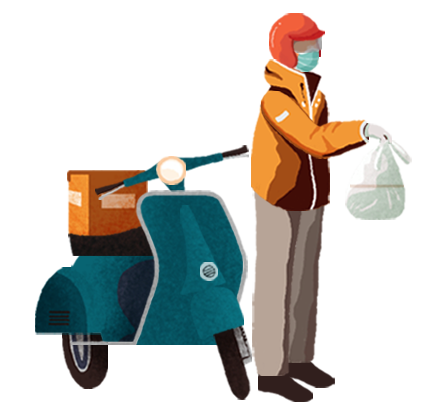








The New Inequality: The “Redistribution” of Mobility during the Pandemic
By Xiang BiaoMobility is a kind of capital. A person’s mobility and opportunities can bring tangible benefits. However, during the epidemic, mobility is no longer capital. The people who truly hold resources are able to be ‘immobile’- they outsource their mobility behavior to other people, such as takeout delivery workers, couriers, security guards, and cleaners, so that life can continue for them during the epidemic. This type of “outsourcing” constitutes a “redistribution of mobility.”; The question is, along with the visibility that the epidemic has brought these service workers, will it also give them a voice and bring about more benefits?
Read More

The New Riders of the Pandemic
By Li NaThe coronavirus pandemic broke right at the start of the Lunar New Year travel rush in China, the biggest human migration on the face of the earth. Transportation routes were closed, and cities were locked down. People who had gone back home for the celebrations couldn’t leave, and those who had stayed behind in their places of work had no work left. In desperation, they turned in droves to gig economy jobs like food delivery. WhyNot spoke to a former programmer, Cheng, and Ali, a former fitness coach who hopes working in the removals business will help him keep his buff physique.
Read More

The Ins and Outs of Pandemic Home-Schooling
By Jeff WuYanjiaqiao Village in the southeast corner of Jiangsu Province, China is over 700-years-old and has a population of less than 6,000 people. Yanjiaqiao Primary School was founded in the early days of the Republic of China and is also around 100 years old. In this rural elementary school, where 70 percent of the students come from other parts of the country, the saying “knowledge changes destiny” is not always true. For students impacted by the Coronavirus epidemic who rely on the internet to take classes at home, this reality has become clearer: having a smartphone and wireless network can connect them to the classroom, but without this connectivity, they are forced to defer their studies.
Read More

Pandemic Halts Hong Kong Protests
By Jing JuHong Kong confirmed its first case of coronavirus on Jan. 22. The authorities issued restrictions on public gatherings on Mar. 28, before relaxing them on May 8 after the city reported no new cases for several days. Hong Kong’s protest movement then went quiet for a couple of months, before the re-emergence of street clashes in July. So what were all the protesters doing during the pandemic? How did it affect them?
Read More

China’s Coronavirus Hospitals: the Workers’ Story
By Dong GuaAt the height of the coronavirus outbreak in the central Chinese city of Wuhan, authorities rushed to build makeshift hospitals at Huoshenshan and Leishenshan. The operation was touted as a shining example of how fast China could get things done. But behind the bustling construction scenes, WhyNot found a different story: workers pressed into service with no contract and with very low pay. Once their work was done, they were then locked up in their dormitories for 14 days, without any of the promised subsidy payments. Eventually, after a long wait and much confusion, they broke out of the dormitory and went to complain to their foremen.
Read More

Working from home under lockdown
By Tong TongThe Pandemic Working Women’s Concern Group recently released a report on the experiences of working-class women in the pandemic, based on a survey of 662 working-class women across 30 Chinese cities and provinces. WhyNot brings you some of the stories behind that data.
Read More

成为第一位留言的人吧!